 Edit article
Edit articleSeries
The Tabernacle in Its Ancient Near Eastern Context

The Tabernacle in the camp. Collectie Nederland
Tabernacle (Hebrew מִשְׁכַּן miškan), literally “dwelling place,” is the main term used by the Torah’s Priestly author to describe YHWH’s tent-shrine.[1] The elaborate form of the Tabernacle, its engineering, and perceived symbolic riddles attracted many of humanity’s sharpest minds over the past two millennia, including Josephus, Philo, Origin, Jerome, Augustine, Bede, Maimonides, Rashi, and Sir Isaac Newton.[2]
The Tabernacle was very important to the Priestly author. Nearly 400 verses are allotted to its form and furnishings, far more detail than comparable structures receive in the Hebrew Bible and other ancient Near Eastern writings. In contrast, Solomon’s Temple and its furnishings receive only 70 verses in 1 Kings 6 and 7.
The Structure of the Tabernacle
Exodus describes the Tabernacle as a broad room structure, with its opening facing the East (26:18-22). The planks or frames (qrš) are of acacia wood, each 10 cubits in height and 1 ½ cubits wide (26:15-17). For most reconstructions, the frames were to be positioned side-by-side, with 20 on each long side (north and south), and six in the back (west) with two corner frames, creating a structure of approximately 30 cubits (13.7 meters / 45 feet) in length, and 10 cubits (4.6 meters / 15 feet) in both width and height.[3] This structure is then covered with two pieces of linen, with an outer covering of red leather (26:1-14).
Inside the Tabernacle is a dividing curtain, with the Holy of Holies in the back room where the Ark of the Covenant was to rest (26:33). In the room before the Holy of Holies, what might be referred to as the “standard Holy” room, sits an incense altar (30:1-10), the Table of Showbread (25:23-30), and a Menorah lampstand (25:31-39). The Tabernacle opens into the center of a large courtyard (27:9-19), measuring 100 cubits in length and 50 cubits in width, and in which the laver for washing (30:17-21) and the large sacrificial altar sit (27:1-8).
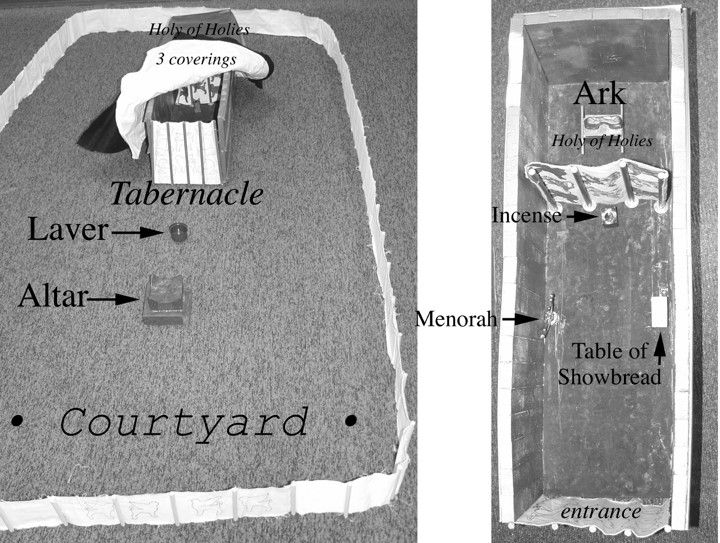
Symbolism
Like many ancient Near Eastern religious structures, the Tabernacle symbolically mirrors the cosmos. The entrance of both the court and tent faced the rising sun.[5] The Menorah has seven lamps, with seven possibly representing the number of luminary bodies visible to the naked eye (Sun, Moon, Mercury, Venus, Mars, Jupiter, and Saturn). The Tabernacle’s lamp was symbolically placed along the southern wall, as the planets would traverse the sky most often south of the structure.
It is uncertain whether the author of Genesis 1 and the Tabernacle account knew about the connection between the number seven and these luminary bodies. But the author might have been influenced by Babylonian tradition, where the connection was more firmly established. For example, the creation story Enuma Elish was composed on seven tablets, and each of the seven layers of the ziggurats were connected specifically with the sun, moon, or one of the five planets.[6]
The twelve lunar cycles in a solar year were also symbolically represented in the Tabernacle, as there were 12 loaves of bread placed on the Table of Showbread every Sabbath (Lev 24:5-9). This finds its best parallel in Egyptian tomb iconography, where a table for the deceased is set with bread loaves, often numbering 12.[7] Additionally, in a Mesopotamian ritual, 12 loaves of bread are placed on a table dedicated to Ishtar.[8]
Designed by God
To build the Tabernacle, the Ark of the Covenant, and the other cultic implements, YHWH appoints two craftsmen, Bezalel and Oholiab (Exod 31:1-11), and the Tabernacle is erected in nine months (Exod 19:1; 40:17).
To ensure that the structure is built properly, YHWH shows Moses a model of what should be built while he is still on the mountain:
שמות כה:ח וְעָשׂוּ לִי מִקְדָּשׁ וְשָׁכַנְתִּי בְּתוֹכָם. כה:ט כְּכֹל אֲשֶׁר אֲנִי מַרְאֶה אוֹתְךָ אֵת תַּבְנִית הַמִּשְׁכָּן וְאֵת תַּבְנִית כָּל כֵּלָיו וְכֵן תַּעֲשׂוּ.
Exod 25:8 And let them make Me a sanctuary that I may dwell among them. 25:9 Exactly as I show you – the model of the Tabernacle and the model of all its furnishings – so shall you make it.[9]
It is likely that the text means that Moses was shown the Tabernacle and its furnishings in a prophetic vision, in the same manner as YHWH shows Ezekiel the future Temple (Ezek 40:4). Alternatively, the biblical text may be implying that the Tabernacle was modeled after YHWH’s celestial home, and that this is what Moses was shown on the Mountain.[10]
The process by which the Tabernacle was revealed and constructed reflects the building accounts of ancient Near Eastern temples. For example, Gudea, the king of Lagash (ca. 2200 BCE), was shown in a dream a model of the temple that he was to build by Ningirsu.[11]
What Happened to the Tabernacle?
The Tabernacle is meant to be a movable dwelling for YHWH that travels along with the Israelites as they traverse the Sinai Wilderness. Thus, when the Israelites depart from Mt. Sinai, they disassemble the Tabernacle and its furnishings, transport it, and then erect it again at their new camp (Numbers 10). This is the procedure assumed by the Priestly text for the entire wilderness period.
According to Joshua 18:1, following the conquest of Israel, the Tent of Meeting (another name for the Tabernacle, used by both the Priestly and non-Priestly texts) was set up in Shiloh.
יהושע יח:א וַיִּקָּהֲלוּ כָּל עֲדַת בְּנֵי יִשְׂרָאֵל שִׁלֹה וַיַּשְׁכִּינוּ שָׁם אֶת אֹהֶל מוֹעֵד וְהָאָרֶץ נִכְבְּשָׁה לִפְנֵיהֶם.
Josh 18:1 The whole community of the Israelite people assembled at Shiloh, and set up the Tent of Meeting there. The land was now under their control;
The book of Samuel describes in Shiloh a “House of YHWH” (1 Sam 1:7), or “Temple of YHWH” (1 Sam 1:9), and in one verse a “Tent of Meeting” (1 Sam 2:22).[12] The family of Eli the priest is in charge of this cultic site until the loss of the Ark in the battle of Ebenezer against the Philistines (1 Sam 4).[13] The Ark is eventually returned to Beth Shemesh and then to Gibeah in Kiryat Yearim (1 Sam 6:13-7:2). Later in Samuel, David brings the Ark of the Covenant to Jerusalem and places it inside of a tent (2 Sam 6). When David offers to build YHWH a Temple, Nathan the prophet relays YHWH’s declination:
שמואל ב ז:ו כִּי לֹא יָשַׁבְתִּי בְּבַיִת לְמִיּוֹם הַעֲלֹתִי אֶת בְּנֵי יִשְׂרָאֵל מִמִּצְרַיִם וְעַד הַיּוֹם הַזֶּה וָאֶהְיֶה מִתְהַלֵּךְ בְּאֹהֶל וּבְמִשְׁכָּן.
2 Sam 7:6 Because I did not dwell in a house since the time that I brought up the children of Israel from Egypt and even to this day, but I have walked in a tent and a Tabernacle.
YHWH’s tent makes a final appearance in the account of the dedication of Solomon’s Temple in Jerusalem:
מלכים א ח:ג וַיָּבֹאוּ כֹּל זִקְנֵי יִשְׂרָאֵל וַיִּשְׂאוּ הַכֹּהֲנִים אֶת הָאָרוֹן. ח:ד וַיַּעֲלוּ אֶת אֲרוֹן יְ-הוָה וְאֶת אֹהֶל מוֹעֵד וְאֶת כָּל כְּלֵי הַקֹּדֶשׁ אֲשֶׁר בָּאֹהֶל וַיַּעֲלוּ אֹתָם הַכֹּהֲנִים וְהַלְוִיִּם.
1 Kings 8:3 When all the elders of Israel had come, the priests lifted the Ark 8:4 and carried up the Ark of YHWH. Then the priests and the Levites brought the Tent of Meeting and all the holy vessels that were in the Tent.[14]
The text never states where in the Temple the tent was brought. Richard Elliott Friedman has argued, based on a comparison between the size of the Tabernacle in Exodus and the space underneath the wings of the large cherubim in the Temple’s Holy of Holies, that it was set up in that space.[15] Rabbinic tradition suggests that it was disassembled and stored in the Temple’s treasury.[16] Like the Ark of the Covenant, the Tabernacle’s ultimate fate after entering the Temple, remains a mystery.
A Historical or Fictional Building?
Is the description of the Tabernacle in Exodus based on a real structure or is it just the production of the Priestly author’s imagination? Towards the end of the 19th century, following the influential work of Karl Graf and Julius Wellhausen, scholars began to doubt the historicity of the Tabernacle. Graf and Wellhausen argued that after the Babylonian Exile, the Priestly source wanted to emphasize the significance of the sacrificial cult, and thus invented a portable sanctuary that served the Israelites already in the time of Moses and Aaron in the Wilderness, thereby enshrining this practice in hoary antiquity. This fictional tent shrine was half the size of the actual Temple of Solomon, and the specifics of its construction merely the workings of the author’s grandiose imagination.[17]
Wellhausen’s theory dominated the field of biblical scholarship until 1947, when Frank M. Cross Jr. drew on pictorial and verbal records from Phoenicia, Ugarit, Egypt and Mesopotamia to show that the description of the Tabernacle correlates well with actual ancient structures.[18] Cross argued that the description in the Priestly text must have been based on written documentation about such a tent.[19] Since Cross’s original article, much more evidence has arisen favoring the historicity of such a structure.
Ancient Near Eastern Textual Parallels
There are many ancient literary parallels to the Tabernacle:
Ugarit – In Late Bronze Age Ugarit, the Canaanite god El along with other deities lived in tent shrines that were frequently called a tent (͗hl) and a Tabernacle (mškn), and shared identical terminology for the tent frames (qrš).[20] In the Epic of Kirta, a divine assembly ends with “The gods bless, they go. The gods go to their tents (lahlhm), the circle of El to their tabernacles (lmšknthm).”[21]
Egypt – In “The Contest of Horus and Seth,” the deities quarrel, and after some name-calling, the text reads “And they went to their tents (‘imw). The great god [Re] slept in his pavilion (sḥ).” This call to return to one’s tent (seen here and in the quotation above from Ugarit) was a common formula to disband assemblies. In fact, the same formula is invoked two times in the Bible. Sheba ben Bichri, to express dissatisfaction with David’s United monarchy, shouts (2 Sam 20:1):
אֵין לָנוּ חֵלֶק בְּדָוִד וְלֹא נַחֲלָה לָנוּ בְּבֶן יִשַׁי אִישׁ לְאֹהָלָיו יִשְׂרָאֵל.
We have no share in David, no part in Jesse’s son. To your tents, O Israel!
Two generations later, the same formula is used when Israel breaks from Rehoboam’s monarchy (1 Kgs 12:20=2 Chron 10:16).
Byblos – Philo of Byblos translated into Greek a Phoenician history ascribed to Sanchuniathon. In the story, a deity likely identified with the Canaanite deity El was transported around the land in a portable shrine.[22]
Mari – In Mesopotamia, several texts from 18th century B.C.E. Mari mention tents, one of which was supported with 10 heavy frames. These texts use the word qersū, cognate to the tent frames at Ugarit and for the Tabernacle (qrš).[23] One Mari text reads,
On the day of the gimkum, tent frames (qersū) are set up (iš-ša-ak-ka-nu—cognate to Hebrew mškn[24]). A donkey is killed. The gods and their paraphernalia depart from the tent frames (qersū). [Each] deity goes to his temple, and the king goes to his palace.[25]
Archaeological Parallels (from Ancient Egypt)
The strongest parallels to the Tabernacle are remarkably found in the very time and place that the Torah purports that the Tabernacle was constructed: Late Bronze Age Egypt.[26]
Tutankhamon – In the burial chamber of the tomb of Pharaoh Tutankhamon, a tent pall (covering) hung above a wooden tent frame overlaid with gold.[27]
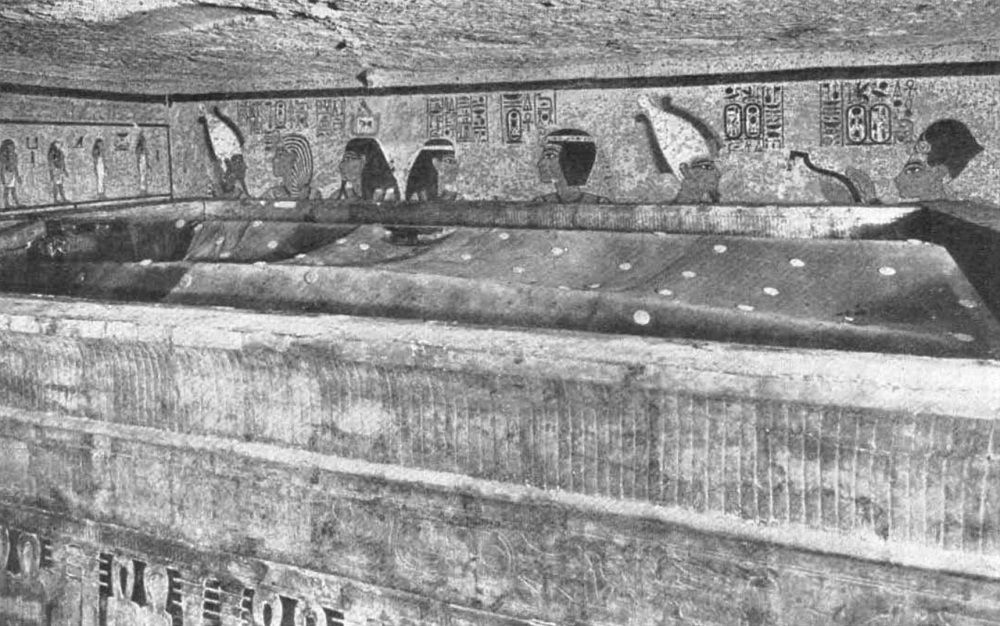
Tent of Hathor –The remains of a tent shrine dedicated to the Egyptian goddess, Hathor (the goddess of mining among other things), were discovered in Timna, Israel. Masses of a thick fabric dyed varying shades of red and yellow were recovered. A copper serpent, remarkably similar to Nehushtan in the Torah (Num 21:8-9), was discovered in the temple’s central niche.[29]
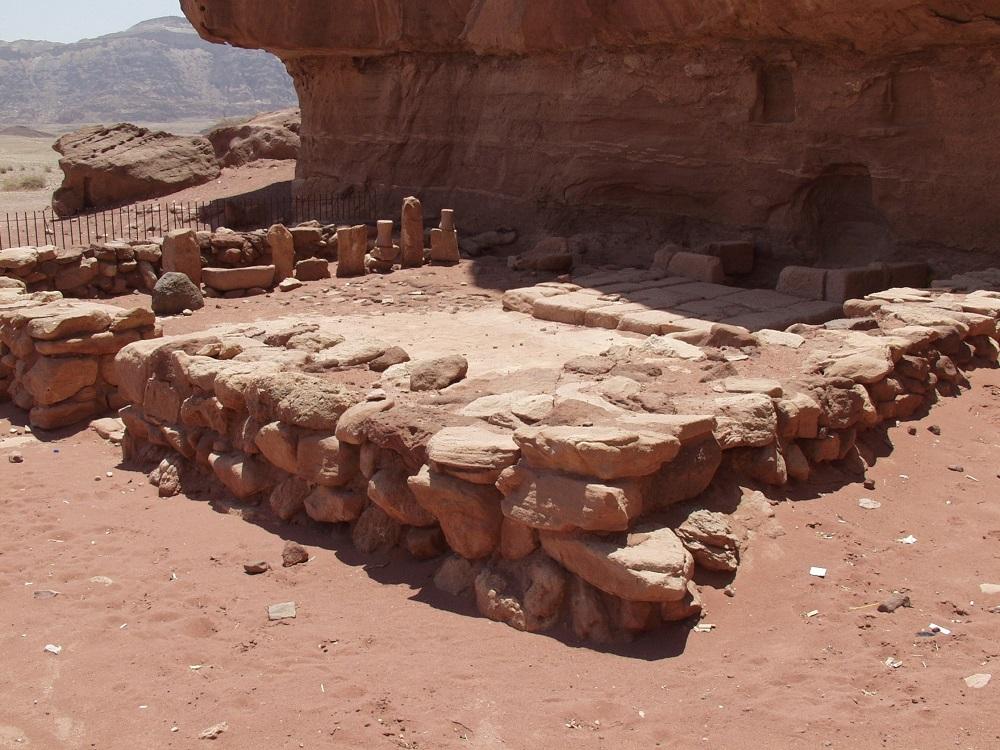
|

|
Frames of Tiye – Similar to Tutankhamon’s tent frames are the gold overlaid frames of a structure belonging to King Akhenaton’s mother-in-law, Tiye. The shrine consists of several wooden planks linked together with mortises and tenons, composing a long-room rectangular catafalque.[31] I believe this provides an example of what the Tabernacle’s frames might have looked like, but without the writing.
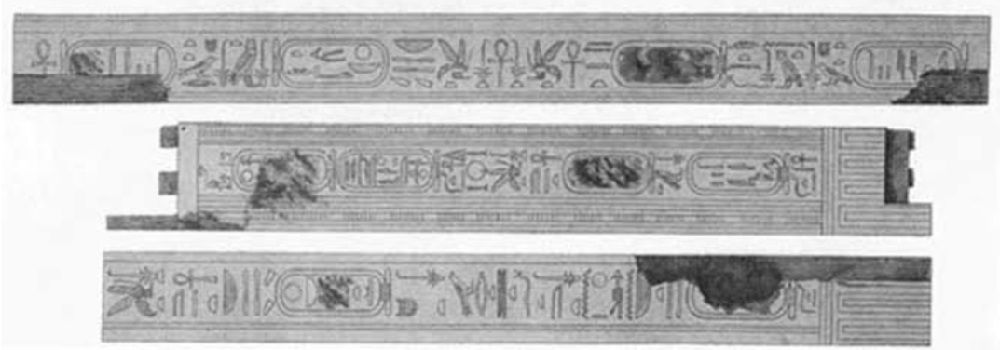
The “Tabernacle” of Rameses II
The closest parallel to the form and function of the Tabernacle stems from pictorial evidence of a military tent camp that Rameses II used to fight the Hittites in the Battle of Qedesh.[33] This battle was so important to Ramesses II that it is described in hieroglyphics in 10 different places throughout ancient Egypt, and scenes of the battle were depicted artistically in five locations. The Egyptian camp of Ramesses II, which parallels the Tabernacle, is portrayed at Abu Simbel, Luxor, and twice at the Ramesseum.[34]
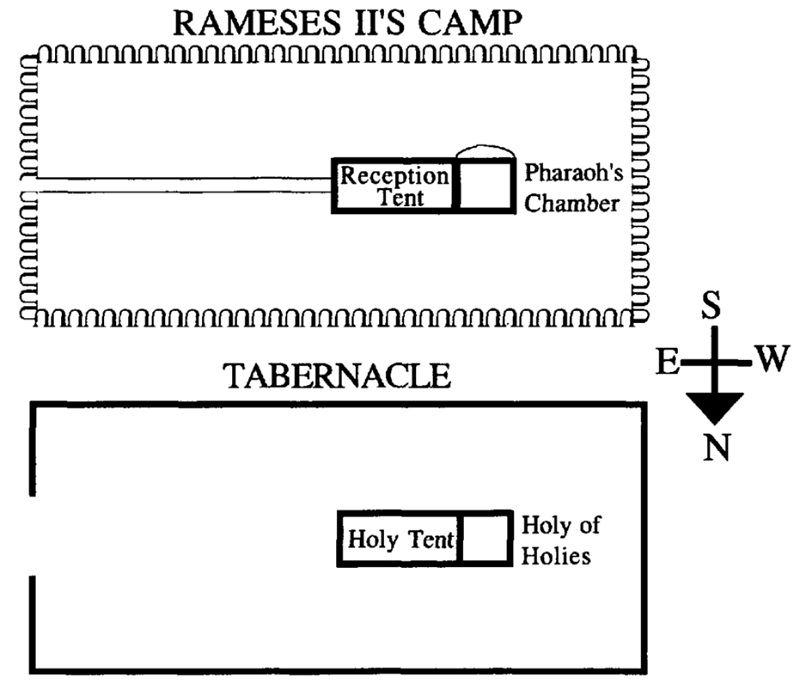
Both structures have rectilinear courtyards orientated to the East, and they are twice as long as they are wide, with the entrance in the center of the eastern short wall. In the camp’s middle is the entrance to a 3:1 long-room tent, composed of a 2:1 reception tent leading to a square throne tent, alternatively labeled Pharaoh’s Chamber or the Holy of Holies for the Tabernacle.
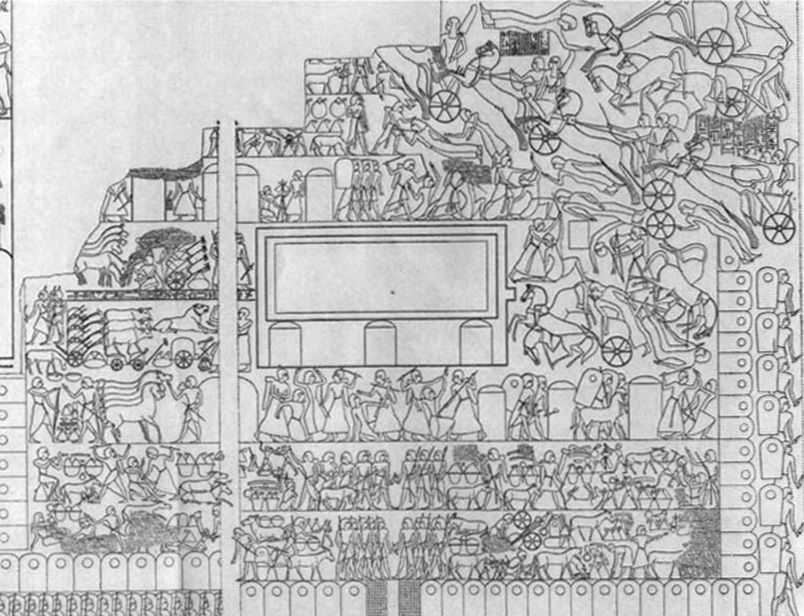
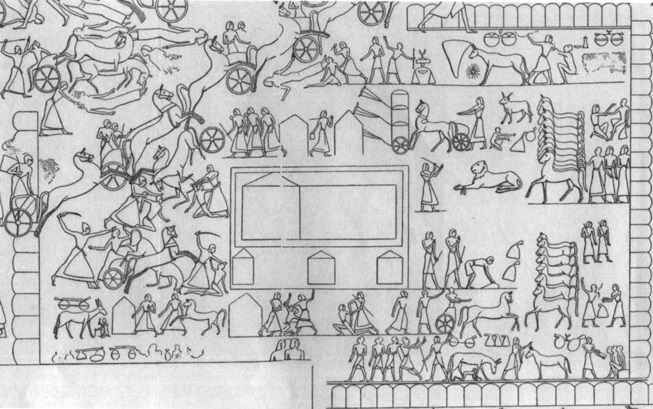

The wall relief of Rameses II’s camp at Qedesh, as carved in southern Egypt at Abu Simbel, also shows a 2:1 rectilinear courtyard with the entrance to the pharaoh’s tent in the center. Subjects are shown kneeling and paying homage to the Pharaoh Rameses II, represented by a cartouche, with the wings of twin Horus figures covering the pharaoh. This is reminiscent of the wings of two cherubim that are described as having covered the Ark of the Covenant’s Mercy Seat in the Tabernacle’s Holy of Holies (Exod 25:18-20).
Other features of the Tabernacle share Late Bronze Age Egyptian parallels. This includes the form and function of the Ark of the Covenant.[39] Similarly, the Tabernacle Menorah, based on terminology, artistic parallels, and craftsmanship, shares similarities with Egyptian lampstands during the Late Bronze period.[40]
YHWH’s Military Tent
The depiction of YHWH’s sacred tent as modeled on a military tent fits with biblical context of YHWH as a “Divine Warrior.”[41] YHWH fights for Israel in Exodus 14-15, owns the tools for war in Deut 32:41-42, and is even called a “man of war” (אִישׁ מִלְחָמָה) in Exodus 15:3 and a “warrior” (גִּבּוֹר מִלְחָמָה) in Ps 24:8. Whenever the Tabernacle and Ark were set to be transported, Moses said (Numbers 10:35):
קוּמָה יְ-הוָה וְיָפֻצוּ אֹיְבֶיךָ וְיָנֻסוּ מְשַׂנְאֶיךָ מִפָּנֶיךָ
Rise up, YHWH! May your enemies be scattered; may your foes flee before you.
Much like Rameses II boasted to have singlehandedly defeated the entire enemy forces at Qedesh, so too YHWH alone defeated the Egyptians according to Exodus 14-15.When the Israelites are at war, God dwells inside their camp (Deut 23:9). Later, when battling the Philistines, the Israelites bring the Ark of the Covenant to the battlefield, though the Philistines are victorious, and they capture the Ark (1 Samuel 4).Many more elements about the Israelite’s wilderness sanctuary mirror ancient military camps:
- The pillars of cloud and fire as signals are reminiscent of the smoke and fire signals used in military camps such as that of Alexander the Great.
- The Priestly author calls the Israelite tribes ṣb’ot “armies.”[42]
- The trumpets and standards have military contexts.[43]
Weapons and Armor in Military and Cultic Tents
Weapons and armor are stored in tents together with holy relics.[44] Ramesses II stores his armor in his tent, and David, after defeating Goliath, puts his armor in his tent (1 Sam 17:54). Although, in theory, this could be interpreted as a reference to David’s residence, we see from a later story that Goliath’s weapons are stored in a cultic place. When David is on the run from Saul, and he stops in the Priestly city of Nob, he asks the priest for weapons:
שמואל א כא:ט וַיֹּאמֶר דָּוִד לַאֲחִימֶלֶךְ וְאִין יֶשׁ פֹּה תַחַת יָדְךָ חֲנִית אוֹ חָרֶב כִּי גַם חַרְבִּי וְגַם כֵּלַי לֹא לָקַחְתִּי בְיָדִי כִּי הָיָה דְבַר הַמֶּלֶךְ נָחוּץ. כא:י וַיֹּאמֶר הַכֹּהֵן חֶרֶב גָּלְיָת הַפְּלִשְׁתִּי אֲשֶׁר הִכִּיתָ בְּעֵמֶק הָאֵלָה הִנֵּה הִיא לוּטָה בַשִּׂמְלָה אַחֲרֵי הָאֵפוֹד אִם אֹתָהּ תִּקַּח לְךָ קָח כִּי אֵין אַחֶרֶת זוּלָתָהּ בָּזֶה...
1 Sam 21:9 David said to Ahimelech, "Haven't you got a spear or sword on hand? I didn't take my sword or any of my weapons with me, because the king's mission was urgent." 9:10 The priest said, "There is the sword of Goliath the Philistine whom you slew in the valley of Elah; it is over there, wrapped in a cloth, behind the ephod. If you want to take that one, take it, for there is none here but that one."…
The sword is kept behind the ephod, a priestly object used for divination and which, according to Exodus, would be stored in the Tabernacle. Similarly, the Philistines place the captured armor of King Saul in the Temple of Ashtarot (1 Sam 31:10).From all the above, we see the strong connection between the divine and the martial.
The Glory of Living in Tents
House-dwelling urban elites composed the majority of literature from the ancient Near East, and as a result there are many negative connotations for tent-dwellers and the impermanence of nomadism.[45] The Hebrew Bible is unusual in that it glorifies a past when the Israelite ancestors dwelled in tents and lived a semi-nomadic pastoral lifestyle. This goes back to Genesis 4, where YHWH favored the sheep offering of Abel over the offerings presented by his brother, a settled farmer.
The Patriarchs and Matriarchs all lived in tents. Setting up booths annually for the holiday of Sukkot pays tribute to the Israelite ancestors who wandered in the wilderness in impermanent structures (Lev 23:43). Biblical authors celebrate people such as the Kenites and Rechabites who forego an urban house-based lifestyle and remain in tents.[46] Tents have positive connotations in Prov 14:11:
בֵּית רְשָׁעִים יִשָּׁמֵד וְאֹהֶל יְשָׁרִים יַפְרִיחַ
The house of the wicked will be destroyed, and the tent of the righteous will flourish.
Similarly, the authors of the Torah fondly remember a past when even their God was mobile, fought for His people, and lived amongst them in the Tabernacle.
TheTorah.com is a 501(c)(3) nonprofit organization.
We rely on the support of readers like you. Please support us.
Published
March 6, 2018
|
Last Updated
November 7, 2025
Previous in the Series
Next in the Series
Before you continue...
Thank you to all our readers who offered their year-end support.
Please help TheTorah.com get off to a strong start in 2025.
Footnotes

Prof. Michael M. Homan, z”l, was Professor of Theology at Xavier University of Louisiana. He received his Ph.D. and M.A. in Ancient History with a focus on Hebrew Bible from UC San Diego. Homan authored To Your Tents, O Israel! , which won the Frank Moore Cross Publications award, and co-authored The Bible for Dummies and The Nine Commandments.
Essays on Related Topics:









